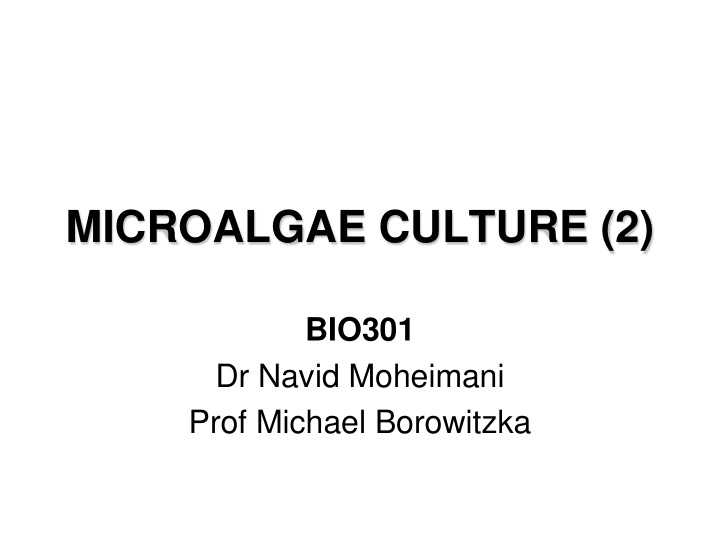



MICROALGAE CULTURE (2) BIO301 Dr Navid Moheimani Prof Michael Borowitzka
Nutrients • Macronutrients (g.l -1 ) • Micronutrients (mg.l -1 ) • Trace Elements ( μ g.l -1 )
Macronutrients - , CO 3 2- , organic molecules CO 2 , HCO 3 C O 2 , H 2 O, organic molecules O H 2 O, organic molecules, H 2 S H + , NO 3 - , NO 2 - , amino acids, purines, pyrimidines, urea, etc N 2 , NH 4 N Na Several inorganic salts, i.e. NaCl, Na 2 SO 4 K Several inorganic salts, i.e. KC1, K 2 SO 4 , K 3 PO 4 Ca Several inorganic salts, i.e. CaCO 3 , Ca 2+ (as chloride) P Several inorganic salts, Na or K phosphates, Na 2 glycerophosphate S Several inorganic salts, MgSO 4 , amino acids 2- , SO 4 2- or Cl - salts Mg Several inorganic salts, CO 3 As Na + , K + , Ca 2+ , or NH 4 - salts Cl
Micronutrients Fe FeCl 3 , Fe(NH 4 ) 2 SO 4 , ferric citrate Zn 2¯ or Cl ¯ salts SO 4 2¯ or Cl - salts Mn SO 4 Br As Na + , K + , Ca 2+ , or NH 4 - salts Si Na 5 SiO 5 9H 2 O B H 5 BO 5
Trace Elements Mo Na + or NH 4 + molybdate salts V Na 5 VO 4 .16H 2 O Sr 2- or Cl - salts SO 4 Al 2- or Cl - salts SO 4 2- or Cl - salts Rb SO 4 Li 2- or Cl - salts SO 4 Cu 2- or Cl - salts SO 4 2- or Cl - salts Co Vitamin B 12 , SO 4 I As Na + , K + , Ca 2+ , or NH 4- salts Se Na 2 SeO 3
Inorganic C CO 2 + H 2 O ⇔ HCO 3 - + H + ⇔ CO 3 2- + H + Note: The pK values are strongly affected by salinity
Organic C {hetrotrophs and/or mixotrophs} • Main form used by algae is acetate (up to about 1 g.l -1 ) • Some can also use glucose • Other organic C sources – ethanol, galactose etc.
N • The usual nitrogen sources in algal media are (1) nitrate; (2) ammonium; or (3) urea • The heterocystous blue-green algae (cyanobacteria), can also fix atmospheric N 2 . - ), nitrite (NO 2 - ) or • Most algae can use nitrate (NO 3 + ) as an N source ammonium (NH 4 • Urea (NH 2 )CO is also potentially a good nitrogen source for almost all algal species. Urea is hydrolysed before its N is incorporated into the algal cells by the action of either the enzyme urease, or the enzyme urea amidolyase (UALase).
Ammonia & Ammonium + NH 3 + H + NH 4 pKa in FW at 20 o C = 9.23
(b) carotenogenesis (a) growth KNO 3 1 g.l -1 NH 4 NO 3 KNO 3 0.5 g.l -1 NH 4 NO 3 Dunaliella salina cultures. ( = 1 g.l -1 KNO 3 ; • = 1 g.l -1 NH 4 NO 3 ; O = 0.5 g.l -1 NH 4 NO 3
P • The major form in which algae take up phosphorous is as inorganic phosphate - and HPO 4 2- ) (H 2 PO 4 • Uptake is optimum at alkaline pH • Can also use organic P compounds • High concentrations of P may be toxic! • Luxury phosphate uptake
S, Ca, Mg, Na, Cl • Required by all algae to some degree • Ca:Mg ratio generally more important than actual concentrations
Si • Most (all?) algae have a low Si requirement • Diatoms have high Si requirement (added as H 4 SiO 4 (silicic acid) • Germanium if added at a molar ratio of Ge/Si of 0.1 to 0.2 inhibits diatom growth
Fe • Essential for ALL algae • Needs to be added in chelated form (i.e. FeCl 2 with EDTA or citrate) to be able to be take up • High concentrations are toxic!
Other bits & Pieces • Vitamins (mainly B 12 and other B series) • Selenium
O 2 • Algae require O 2 (but some can survive periods of anoxia) • High O 2 will inhibit photosynthesis (photorespiration) • Competes as substrate for Ribulose,bis- phosphate carboxylase/oxygenase
Isolating Algae • Enrichment Culture • Serial Dilution • Single cell isolation • ‘streaking’ on agar plates and colony selection • Density Centrifugation • The ‘spray’ method
Recommend
More recommend